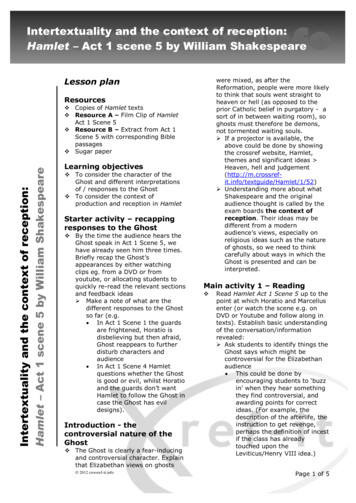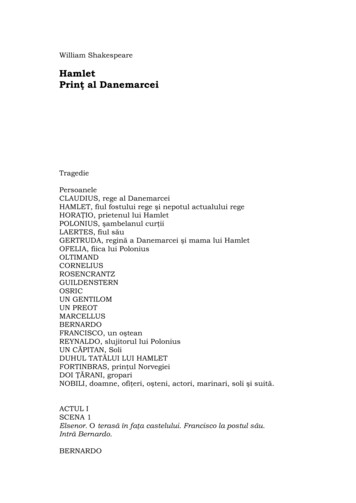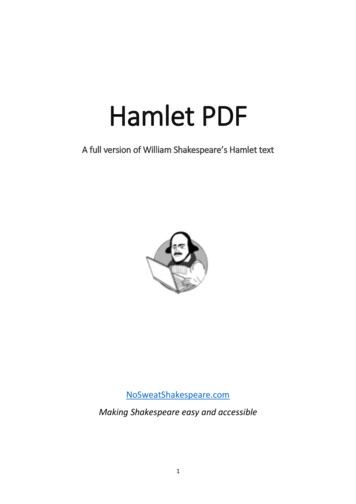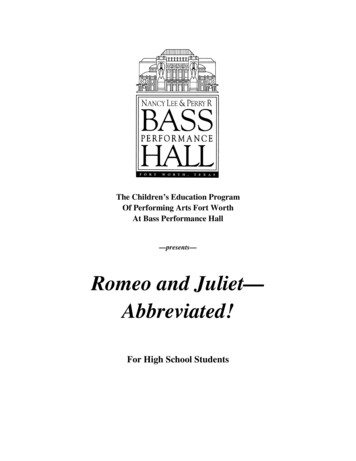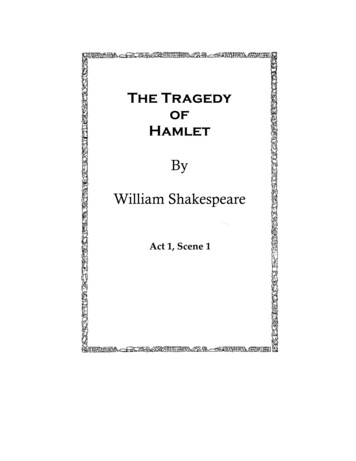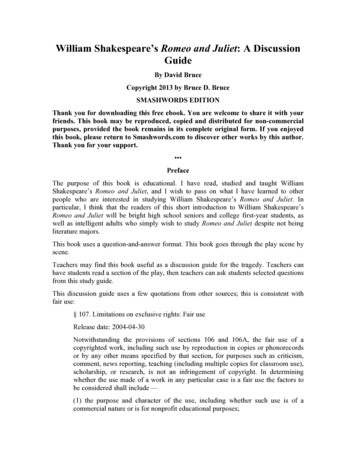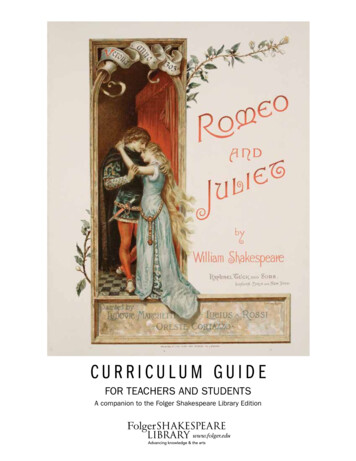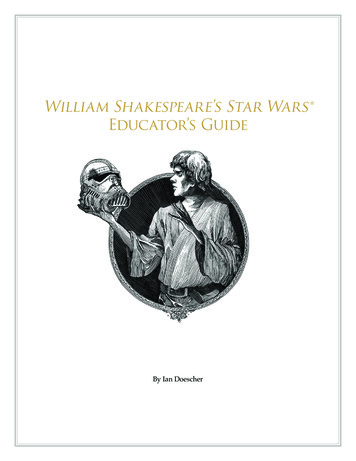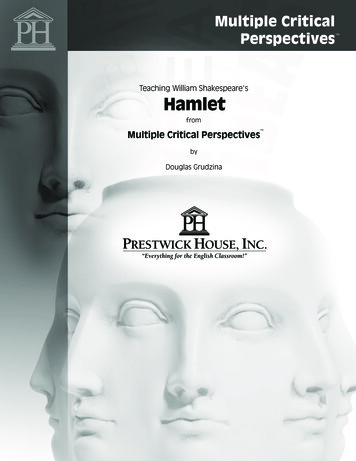
Transcription
Multiple CriticalPerspectivesTeaching William Shakespeare'sHamletfromMultiple Critical PerspectivesbyDouglas Grudzina
Multiple CriticalPerspectivesHamletOther titles in the Multiple Critical Perspective series include:A convenient order form is located in the back of this book.1 984Animal FarmAnthemAntigone Awakening, The Brave New World Crucible, TheCry, The Beloved CountryDeath of a SalesmanDoll’s House, AEthan FromeFrankensteinGrapes of Wrath, The Great Expectations Great Gatsby, The HamletHeart of DarknessHouse on Mango Street, TheImportance of Being Earnest, TheInvisible Man (Ellison)Jane EyreKing LearLife of PiLord of the Flies Macbeth Metamorphosis, The Midsummer Night’s Dream, A Much Ado About Nothing Oedipus Rex Of Mice and Men Our TownPicture of Dorian Gray, ThePride and PrejudiceRaisin in the Sun, ARichard IIIRomeo and JulietScarlet Letter, The Separate Peace, ASiddhartha Slaughterhouse-FiveTale of Two Cities, ATaming of the Shrew, TheTempest, The Things Fall ApartTo Kill a Mockingbird Twelfth Night Wuthering HeightsP.O. Box 658, Clayton, DE 19938www.prestwickhouse.com 800.932.4593ISBN 978-1-60389-416-6Item No. 301553Copyright 2006 Prestwick House, Inc. All rights reserved.No portion may be reproduced without permission in writing from the publisher.2Pr e s t w i c kHo u s e,In c.
HamletMultiple CriticalPerspectivesA Message to theTeacher of LiteratureOpen your students’ eyes and mindswith this new, exciting approach to teaching literature.In this guide, you will find reproducible activities, as wellas clear and concise explanations of three contemporarycritical perspectives—feel free to reproduce as much, oras little, of the material for your students’ notebooks. Youwill also find specific suggestions to help you examinethis familiar title in new and exciting ways. Your studentswill seize the opportunity to discuss, present orally, andwrite about their new insights.What you will not find is an answer key. To the feminist, the feminist approach is the correct approach, justas the Freudian will hold to the Freudian. Truly, the pointof this guide is to examine, question, and consider, notmerely arrive at “right” answers.You will also find this to be a versatile guide. Use it inconcert with our Teaching Unit or our Advanced Placement Teaching Unit. Use it along with our Response Journal, or use it as your entire study of this title. Howeveryou choose to use it, we are confident you’ll be thrilledwith the new life you find in an old title, as well as inyour students.Pr e s t w i c kHo u s e,In c.3
Multiple CriticalPerspectivesHamletTable of ContentsGeneral Introduction To The Work. 6Introduction to Hamlet. 6List of Characters. 8Synopsis. 10Feminist Theory Applied to Hamlet. 15Notes on the Feminist Theory. 15Essential Questions for A Feminist Reading. 18Activity One: Examining Gertrude’s Options as A Woman inHamlet’s Society. 19Activity Two: Examining Ophelia’s Role as Pawn or Participant. 20Activity Three: Examining Gertrude’s and Ophelia’s Role’s asPawn or Participants. 28Discussion Questions. 29Essays Or Writing Assignments. 294Pr e s t w i c kHo u s e,In c.
HamletMultiple CriticalPerspectivesPsychoanalytic/Freudian Theory Applied to Hamlet. . 31Notes on the Psychoanalytic Theory. 31Essential Questions for A Psychoanalytic Reading. 34Activity One: Examining Oedipal Influences in Hamlet. 35Activity Two: Exmining Fortinbras as Id, Hamlet as Superego, andLaertes as Ego. 36Activity Three: Examining as an Expression of PersonalGrief and Societal Fin De Siécle. 37Discussion Questions. 41Essays Or Writing Assignments. 41Mythological/Archetypal Applied to Hamlet. . 43Notes on the Mythological/Archetypal Approach. 43Essential Questions for A Mythological Reading. 46Activity One: Examining Archetypal Symbols in the Play. 47Activity Two: Examining Archetypal Characters in the Play. 48Activity Three: Examining Archetypal Situations in the Play. 49Discussion Questions. 50Essays Or Writing Assignments. 50Pr e s t w i c kHo u s e,In c.5
Multiple CriticalPerspectivesHamletGeneral Introduction to the WorkIntroduction to HamletHamlet is a play, specifically a tragedy, and more specifically a Shakespearean tragedy. A Shakespeareantragedy generally involves a tragic hero (Hamlet) who holds an elevated position in his society(Prince of Denmark, son of the late king and current queen, nephew to the current king).Some key character trait (Hamlet is a thoughtful, contemplative, and scholarly man) motivates thehero to perform an action or to set in motion a series of actions. (Hamlet is called to avenge his father’smurder, but finds vengeance difficult to achieve while he has questions about the true nature of hisfather’s ghost, his uncle’s guilt, and his mother’s virtue. It is more in Hamlet’s nature to ponder the variouspossibilities and their consequences than to actually take action. Ultimately, however, his inaction drawsmore and more people into the circle of corruption that will eventually have to be destroyed.)This series of actions creates intense suffering both for the hero and for the society at large (Hamlet isplagued by intense guilt about his failure to achieve revenge. The method he chooses to assess his uncle’sguilt hurts his mother and his girlfriend, ultimately resulting in his girlfriend’s death. His own insecurityallow him to trust virtually no one, including his own mother, his girlfriend, and two childhood friendswho have come to “help” him. This distrust erupts into violence once Hamlet reaches the point of beingable to take action.) Finally, the hero is killed by someone who has been caught up in the overall intensesuffering (Hamlet is killed by Laertes, whose father and sister Hamlet has essentially destroyed). Peaceand order are restored.Sometimes an outside agent (a villain or some other intruder) acts as a catalyst to the hero’s beginning the action or series of actions. (Hamlet is already grieving his father’s death and lamenting hismother’s remarriage when the ghost appears, but the fatal distrust of Rosencrantz and Guildenstern andthe involvement of Laertes and Ophelia are the result of the ghost’s appearance and call to vengeance.)William Shakespeare (1564 – 1616) wrote Hamlet (c. 1599—1601) when he was approaching whatwould be middle-age for an Elizabethan. In 1596, Shakespeare’s only son, Hamnet, died suddenly after abrief illness at the age of eleven. Evidence of Shakespeare’s profound grief can be found in several playswritten after this event.Prior to Hamlet, Shakespeare’s fame and literary success were based on his comedies, most notablyA Midsummer Night’s Dream, Much Ado About Nothing, As You Like It, and The Merry Wives of Windsor.Hamlet began a long string of tragedies—those plays now called “The Great Tragedies”—and the onlycomedies Shakespeare wrote in this period are the fairly un-funny “problem plays”: All’s Well that EndsWell, and Measure for Measure.6Pr e s t w i c kHo u s e,In c.
HamletMultiple CriticalPerspectivesMany critics and historians speculate on what—in addition to the grief of his son’s death—mighthave motivated Shakespeare’s vision to evolve from the social, unifying view of life portrayed in comedyto the insular, brooding view of tragedy. Among possible key events (both personal and societal) thatmight be reflected in this change of dramatic view are: Shakespeare’s father died in 1601; Also in 1601, Shakespeare probably lost his patronage when the Earl of Southampton was arrested(though ultimately reprieved) for his role in the failed Essex rebellion; Turns-of-the-century are usually accompanied by a societal lassitude that may have shown itself asa public demand for more serious material.In any event, the story of the “melancholy Dane” marked a departure for the playwright Shakespearefrom his standard fare and ushered in a years-long period of tragic composition.Pr e s t w i c kHo u s e,In c.7
Multiple CriticalPerspectivesHamletList of CharactersClaudius – King of DenmarkHamlet – son to the late King, and nephew to the present KingGertrude – Queen of Denmark, and mother to HamletPolonius – Lord ChamberlainHoratio – friend to HamletLaertes – son to PoloniusOphelia – daughter to PoloniusVoltimand and Cornelius – courtiers and ambassadors to the KingRosencrantz and Guildenstern – childhood friends of HamletOsric – a courtierA GentlemanA PriestMarcellus and Bernardo – officers in the castle guardFrancisco – a soldierReynaldo – servant to PoloniusTraveling PlayersLucianus – a character in the play-within-the-playTwo grave-diggers8Pr e s t w i c kHo u s e,In c.
HamletMultiple CriticalPerspectivesFortinbras – Prince of NorwayA Captain in the Norwegian armyEnglish AmbassadorLords, Ladies, Officers, Soldiers, Sailors, Messengers, and other AttendantsGhost of Hamlet’s FatherPr e s t w i c kHo u s e,In c.9
Multiple CriticalPerspectivesHamletSynopsisAct IScene IAn immediate sense of suspense is established as the guard coming onto duty accosts the guardalready on duty. The source of their unease is an impending invasion by Norway and the appearance ofthe ghost of their late king. Horatio, a scholar, comes to witness the ghost’s appearance and to try to speakwith him.Scene IIIn a formal scene of State, Claudius, King of Denmark, sets the record of recent events: the death ofhis brother, the former king, is still recent enough that it would be appropriate for the country to be ina period of mourning. Nonetheless, Claudius has married his widowed sister-in-law and assumed thethrone of Denmark. He also informs the court of the threatened Norwegian invasion and sends twoambassadors to the bedridden king of Norway to rein his nephew Fortinbras in.Continuing his official business, Claudius grants Laertes, son of the Lord Chamberlain, permission toreturn to France, while denying his nephew/stepson Hamlet permission to return to school in Wittenberg.Both Claudius and Gertrude chastise Hamlet for his seeming to grieve excessively for his father, andClaudius names Hamlet heir to his throne. In his first soliloquy, Hamlet expresses a desire to die and historment over his mother’s incredibly quick marriage to his uncle. Horatio and the two guards enter to tellHamlet about the appearances of his father’s ghost. Hamlet agrees to watch with them that night.Scene IIILaertes takes leave of his sister Ophelia and warns her not to give serious consideration to the attention paid to her by Hamlet. Hamlet has a reputation as a womanizer and could not marry Ophelia evenif he did love her, as Hamlet would have to make a match that would benefit the kingdom he will oneday rule. Polonius echoes similar sentiments and commands Ophelia to end her correspondence withHamlet and return whatever letters and gifts he may have sent. He then says good-bye to Laertes withsuperficial and self-contradictory advice.Scene IVThat night, Hamlet, the two guards, and Horatio meet on the platform of the Castle to await theappearance of the ghost. When it appears, it beckons Hamlet to follow him to a private place.10Pr e s t w i c kHo u s e,In c.
HamletMultiple CriticalPerspectivesScene VThe ghost tells Hamlet that—despite the commonly-accepted story that he was bitten by a snake whilesleeping in his garden—he was in fact murdered by Claudius, who poured poison in his ear while he wassleeping. The ghost further demands that Hamlet avenge his murder but warns the prince not to do anythingto Gertrude. Hamlet then extracts an oath from his companions that—should he begin to act as if he weremad—they will give no sign that they know what he is doing or why.Act IIScene IPolonius is sending a servant to Paris to spy on his son Laertes. In order to ferret out information aboutthe son’s lifestyle, Polonius advises the servant to spread rumors about Laertes’ gambling, drinking, etc., tosee what kind of response he gets. Ophelia enters and describes for her father an encounter she has had withHamlet in which he appeared in her room, unkempt and melancholy—the Renaissance image of the unrequited man in love. Polonius assumes that Hamlet’s recent madness must be the result of his love for Ophelia,and he runs to tell the king and queen.Scene IIClaudius and Gertrude welcome Rosencrantz and Guildenstern, whom they have summoned to visitHamlet and find out the cause of his melancholy and his apparent madness. The king and queen insist thatRosencrantz and Guildenstern were summoned because they were childhood friends of Hamlet, and he stillspeaks of them often. They further insist that their only motive in wanting to find the cause of Hamlet’s maladyis so that they can help him get better.The ambassadors that Claudius sent to Norway have returned with the news that Fortinbras no longerintends to invade Denmark. He now wishes to invade Poland and requests Claudius’ permission to marchhis army peacefully through Denmark. Polonius informs Claudius and Gertrude that he believes the cause ofHamlet’s madness to be unrequited love for his daughter Ophelia. Polonius engages Hamlet in a conversation,in which the “mad” Hamlet plays with words, ambiguities, and double entendres. He subtly calls Polonius apimp for being willing to sell his daughter for political advancement, and insults Polonius’ apparent senility.Rosencrantz and Guildenstern greet Hamlet, and he manages to make them confess that they are at courtbecause they were sent for. Hamlet assumes they are spies in league with Claudius. When he expresses disinterest in worldly concerns, the childhood friends inform him of the troupe of traveling players they met on theroad. Hamlet is excited at the prospect of having the players come to Elsinore. The players arrive, and Hamlethas them enact a scene from the Trojan legend of the slaying of King Priam. This enactment is the occasionfor Hamlet’s second soliloquy, in which he berates himself for having taken no action in avenging his father’smurder. He decides that he will use the play to discern Claudius’ guilt and then act.Pr e s t w i c kHo u s e,In c.11
Multiple CriticalPerspectivesHamletAct IIIScene IRosencrantz and Guildenstern report that Hamlet has been very successful in evading their attemptsto learn what is troubling him. Gertrude confesses that she believes it is simply the death of Hamlet’sfather and her own “o’erhasty marriage.” Polonius insists the cause is love for his daughter, so they allarrange to have Hamlet and Ophelia meet, and they will spy on the couple.Hamlet delivers his third soliloquy in which he reiterates his desire to die, but admits that the fearof “something” after death makes humans cling to life. He alludes to every one of the problems that heis himself facing in Denmark at this time. In his conversation with Ophelia, he again speaks in puns andambiguities. He seems to accuse Ophelia of being a temptress and a seductress, and urges her to go eitherto a brothel or to a convent. Broken-hearted, Ophelia laments the fine mind and excellent personalitythat Hamlet once had and has apparently lost.Scene IIHamlet instructs the players how not to over-act or underact, and to keep their performances faithful to the lines written for them (especially the clowns). He confesses to Horatio that he has a particularaffection for him because Horatio is the type of person who can maintain poise and dignity no matterhow good or bad circumstances are. He also asks Horatio to pay close attention to Claudius’ reaction tothe players’ performance, as this will hopefully elicit a response that will indicate the king’s guilt.Before the play and during the prologue, Hamlet continues to torment Ophelia with vulgar jokes.He essentially narrates the prologue and the beginning of the play, and Claudius is so moved with guiltduring the enactment of the killing of the king that he cannot even remain in the room. Hamlet assailsRosencrantz and Guildenstern for their foolish attempts to plumb the mystery of his melancholy, andPolonius summons Hamlet to his mother’s room. In a closing speech, Hamlet expresses the fear that—inhis mood following his assessment of Claudius’ guilt—he will harm his mother. He concludes that hemust be cruel to her but will not cause her any physical injury.Scene IIIClaudius states his intention to send Hamlet to England, to keep himself safe from Hamlet’s madness.Polonius tells Claudius that Hamlet is going to Gertrude’s room. Polonius says that he will hide behind acurtain and listen to their conversation because they cannot trust Hamlet’s mother to give a true and objective account. Claudius kneels, as if to pray, and laments that he knows he has committed a grievous offense,yet how can he repent of the sin and keep what he has gained by sinning: his crown and his queen? Hamletcomes upon Claudius while his is in this prayerful attitude, and decides not to kill him now. To kill Claudiuswhile he is praying would send him instantly to heaven, and this is not sufficient revenge for Hamlet.12Pr e s t w i c kHo u s e,In c.
HamletMultiple CriticalPerspectivesScene IVIn Gertrude’s room, Hamlet addresses his mother firmly and rudely. At one point, she is afraid thathe means to hit—or possibly kill—her. Polonius calls out for help from behind the curtain, and Hamletstabs him. Hamlet then forces his mother to compare miniature portraits of her first and second husbands. Claudius fails miserably in the comparison, and Gertrude begins to see how base and vulgar hermarriage to Claudius really is. Hamlet makes her promise to engage in no more marital relations withClaudius, and he leaves, dragging Polonius’ body behind him.Act IVScene IGertrude reports to Claudius the circumstances of Polonius’ death, but she does not give a full andaccurate account. Claudius is now more determined than ever to send Hamlet to England.Scene IIRosencrantz and Guildenstern try to get Hamlet to tell them where he has hidden Polonius’ body.Scene IIIClaudius summons Hamlet to demand where he has hidden Polonius’ body. In a brief closing soliloquy, Claudius reveals that he intends to send letters with Rosencrantz and Guildenstern ordering theEnglish king to execute Hamlet.Scene IVOn his way to the ship to England, Hamlet meets a captain of the Norwegian army, marching throughDenmark on their way to invade Poland. They are going to war over a worthless piece of land that Polandwill fight to defend. The sight of the marching soldiers reminds Hamlet that, even though he has muchto motivate him to action, he has taken none.Scene VOphelia, in her madness, sings bawdy songs. Claudius orders Horatio to keep watch over her. Laertesenters, followed and supported by a rebellious mob. Laertes demands to know the circumstances of hisfather’s death and the reason for his hasty and unceremonious burial. Ophelia returns, and Laertes seesthat she has gone mad. Claudius promises to tell Laertes the full story of how everything happened.Pr e s t w i c kHo u s e,In c.13
Multiple CriticalPerspectivesHamletScene VISailors deliver a letter to Horatio from Hamlet explaining that Hamlet’s ship was besieged by pirates andHamlet alone has been returned to Denmark.Scene VIIClaudius tells Laertes that Polonius’ death and Ophelia’s madness are all Hamlet’s responsibility, yetClaudius does not dare deal with him because Gertrude loves him and the people favor him. A letter arrivesfrom Hamlet saying that he has been returned to Denmark, destitute, and demands an audience with the king.Laertes and Claudius plot to kill Hamlet; Laertes will duel with a poisoned foil, and Claudius will offer Hamleta poisoned cup of wine. Gertrude enters and describes the circumstances of Ophelia’s death by drowning.Act VScene IOn their way to Elsinore, Hamlet and Horatio encounter two gravediggers . As the gravedigger unearthsskull after skull in the digging of a fresh grave, Hamlet and Horatio speculate on whose skull it is and howthe person’s wealth, rank, or accomplishments on earth do not matter at all after death. The gravedigger thenunearths the skull of Yorick, the former court jester. What turns out to be Ophelia’s funeral procession enters.Laertes is upset that she has been denied more ceremony, but her death is suspected of being a suicide. Hamletreveals himself, and he and Laertes fight in Ophelia’s grave.Scene IIHamlet’s concept of death has matured to the point that he is now able to recognize death as inevitableand ordained by Providence. The fawning Osric arrives to deliver a challenge from Laertes to a gentlemanlyfencing match. Hamlet tells Horatio about Claudius’ plot to have the English king execute him, but he foundthe letters and changed them to order Rosencrantz’s and Guildenstern’s executions. During the fencingmatch, Laertes and Hamlet switch swords, and Laertes is wounded with the poisoned sword. Gertrude drinksfrom the poisoned cup. Laertes wounds Hamlet with the poisoned sword and then confesses everything.Gertrude dies. Hamlet wounds Claudius with the poisoned sword and forces him to drink the poisoned wine.They all die. The English ambassador arrives to announce that Rosencrantz and Guildenstern have beenexecuted as requested in the king’s letters. Fortinbras enters and assumes the throne of Denmark, as theDanish Royal Family is now defunct, and he does have a legitimate claim to the throne. He orders a hero’sburial for Hamlet. 14Pr e s t w i c kHo u s e,In c.
HamletMultiple CriticalPerspectivesFeminist TheoryApplied to HamletNotes on the Feminist ApproachFeminism is an evolving philosophy,and its application in literatureis a relatively new area of study. The basis of the movement, bothin literature and society, is that the Western world is fundamentallypatriarchal (i.e., created by men, ruled by men, viewed through theeyes of men, and judged by men).The social movement of feminism found its approach to literaturein the 1960s. Of course, women had already been writing and publishing for centuries, but the 1960s saw the rise of a literary theory.Until then, the works of female writers (or works about females)were examined by the same standards as those by male writers (andabout men). Women were thought to be unintelligent (at least in partbecause they were generally less formally educated than men), andmany women accepted that judgement. It was not until the feministmovement was well under way that women began examining old textsto reevaluate their portrayal of women and writing new works to fitthe “modern woman.”The feminist approach is based on finding suggestions of misogyny (negative attitudes about women) within pieces of literature andexposing them. Feminists are interested in exposing elements in literature that have been accepted as the norm by both men and women.They have even dissected many words in Western languages that arebelieved to be rooted in masculinity. Feminists argue that since thepast millennia in the West have been dominated by men—whetherthey be the politicians in power or the historians recording it all—Western literature reflects a masculine bias, and consequently, represents an inaccurate and harmful image of women. In order to fix thisimage and create a balanced canon, works by females and works aboutfemales should be added and judged on a different, feminine scale.Pr e s t w i c kHo u s e,In c.15
Multiple CriticalPerspectivesHamletThree main areas of study/points of criticism:1.differences between men and women2.women in power or power relationships between men and women3.the female experience1. Differences between men and women The basic assumption is that gender determines everything, including values and language. The canon must be expanded to include the study of those genres in which women “traditionally”write: journals, diaries, and personal letters. Note the differences in the topics or issues about which men and women write and the perspectivesfrom which they write about them.2. Women in power or power relationships between men and women Note and attack the social, economic, and political exploitation of women. Note whether womenhave any power and what type it is. Society has not treated all of its constituencies with equality, and literature is a means by whichinequities can be identified, protested, and possibly rectified. Note the division of labor and economics between men and women. Note how men and women interact with one another in a variety of relationships (romantic, professional, etc.) Does the woman act in any way subservient to the man? Does the man treat thewoman like an adult? A political and economic equal?3. The female experience On the most basic level, women experience different things in life than men do. Examine whataspects of feminine life are included in the work. Note the point of view through which the eventsare told. Is it male or female? Pay attention to how the narrator, male or female, treats the events.For example, are they depicted with sensitivity, harshness, etc.16Pr e s t w i c kHo u s e,In c.
HamletMultiple CriticalPerspectives Reject any view of female personality in contrast to male personality. Feminists believe that thefemale personality is a separate entity from the male personality, and if judged by the same measures, is judged incorrectly. The female personality can stand independent of the male personality,just as the male can stand independent of the female. Examine, and possibly celebrate, the creative, life-giving role of femininity. Though traditionallywomen have been portrayed as dependent on men for everything, the fact is that men are dependent on women for the most basic necessity in the world—birthing children. A male’s relationshipto his mother has always been portrayed as a very strong bond (whether in the Freudian theory ofthe Oedipal complex or modern phrases such as “Mama’s boy”). Explore the concept that men and women are both incomplete without each other (women cannotconceive without men, etc.) not of feminine “incompleteness” alone (Adam’s rib, Freudian theorieson sexuality, etc.). Pr e s t w i c kHo u s e,In c.17
Multiple CriticalPerspectivesHamletEssential Questions for A Feminist Reading1. What stereotypes of women are present? Are female characters oversimplified? Weak? Foolish?Excessively naive?2. Do the female characters play major or minor roles in the action of the work? Are they supportiveor independent? Powerless or strong? Subservient or in control?3.If the female characters have any power, what kind is it? Political? Economic? Social? Psychological?4.How do the male characters talk about the female characters?5.How do the male characters treat the female characters?6.How do the female characters act toward the male characters?7.How do the female characters act toward each other?8.Is the work, in general, sympathetic to female characters? Too sympathetic?9. Are the female characters and situations in which they are placed oversimplified or presented fullyand in detail?10. What are the predominant images? Are they images usually associated with women? Why or why not?11. Do any of the work’s themes touch upon any idea that could be seen as a feminist issue? Is the themesupportive or disparaging of women?12. Overall, do you think that the female characters are believable (based on women you know)? Forthat matter, do you think that the male characters are believable?18Pr e s t w i c kHo u s e,In c.
HamletMultiple CriticalPerspectivesActivity OneExamining Gertrude’s Options as A Woman in Hamlet’s Society1. As a class, look at Claudius’ first introduction of Gertrude in Act I, scene ii: “our sometime sister,now our queen, / The imperial jointress to this warlike state.”2. Have students look up jointure and jointress in the dictionary. Discuss the significance of Gertrude’sbeing identified as the “imperial jointress.” Might Gertrude’s status have had an impact on her decision to marry Claudius? Might Gertrude’s status have had an impact on Claudius’ desire to marry her?3. Next, discuss what Claudius means when he says: “nor have we herein barr’d / Your better wisdoms,which have freely gone / Wi
William Shakespeare (1564 – 1616) wrote Hamlet (c. 1599—1601) when he was approaching what would be middle-age for an Elizabethan. In 1596, Shakespeare’s only son, Hamnet, died suddenly after a brief illness at the age of eleven. Evidence of Shakespeare’s profound grie
